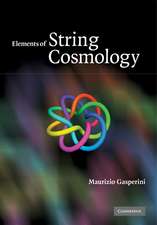The Bottom of the Main Sequence — And Beyond: Proceedings of the ESO Workshop Held in Garching, Germany, 10–12 August 1994: ESO Astrophysics Symposia
Editat de Christopher G. Tinneyen Limba Engleză Paperback – 23 aug 2014
Din seria ESO Astrophysics Symposia
- 15%
 Preț: 656.43 lei
Preț: 656.43 lei - 15%
 Preț: 656.10 lei
Preț: 656.10 lei -
 Preț: 369.78 lei
Preț: 369.78 lei -
 Preț: 404.51 lei
Preț: 404.51 lei - 15%
 Preț: 644.95 lei
Preț: 644.95 lei - 15%
 Preț: 656.43 lei
Preț: 656.43 lei -
 Preț: 391.97 lei
Preț: 391.97 lei - 18%
 Preț: 971.01 lei
Preț: 971.01 lei -
 Preț: 434.94 lei
Preț: 434.94 lei - 15%
 Preț: 650.86 lei
Preț: 650.86 lei -
 Preț: 402.98 lei
Preț: 402.98 lei -
 Preț: 403.90 lei
Preț: 403.90 lei -
 Preț: 412.78 lei
Preț: 412.78 lei - 15%
 Preț: 645.47 lei
Preț: 645.47 lei -
 Preț: 431.30 lei
Preț: 431.30 lei - 15%
 Preț: 649.06 lei
Preț: 649.06 lei -
 Preț: 402.56 lei
Preț: 402.56 lei - 15%
 Preț: 647.27 lei
Preț: 647.27 lei -
 Preț: 413.15 lei
Preț: 413.15 lei -
 Preț: 409.30 lei
Preț: 409.30 lei -
 Preț: 430.10 lei
Preț: 430.10 lei -
 Preț: 406.42 lei
Preț: 406.42 lei - 15%
 Preț: 658.05 lei
Preț: 658.05 lei - 20%
 Preț: 590.38 lei
Preț: 590.38 lei -
 Preț: 400.65 lei
Preț: 400.65 lei -
 Preț: 413.15 lei
Preț: 413.15 lei - 15%
 Preț: 658.70 lei
Preț: 658.70 lei -
 Preț: 401.79 lei
Preț: 401.79 lei -
 Preț: 436.70 lei
Preț: 436.70 lei -
 Preț: 404.13 lei
Preț: 404.13 lei
Preț: 642.18 lei
Preț vechi: 755.51 lei
-15% Nou
Puncte Express: 963
Preț estimativ în valută:
122.90€ • 127.83$ • 101.46£
122.90€ • 127.83$ • 101.46£
Carte tipărită la comandă
Livrare economică 14-28 aprilie
Preluare comenzi: 021 569.72.76
Specificații
ISBN-13: 9783662224823
ISBN-10: 3662224828
Pagini: 332
Ilustrații: XVII, 309 p. 134 illus.
Dimensiuni: 155 x 235 x 22 mm
Greutate: 0.47 kg
Ediția:Softcover reprint of the original 1st ed. 1995
Editura: Springer Berlin, Heidelberg
Colecția Springer
Seria ESO Astrophysics Symposia
Locul publicării:Berlin, Heidelberg, Germany
ISBN-10: 3662224828
Pagini: 332
Ilustrații: XVII, 309 p. 134 illus.
Dimensiuni: 155 x 235 x 22 mm
Greutate: 0.47 kg
Ediția:Softcover reprint of the original 1st ed. 1995
Editura: Springer Berlin, Heidelberg
Colecția Springer
Seria ESO Astrophysics Symposia
Locul publicării:Berlin, Heidelberg, Germany
Public țintă
ResearchCuprins
I Modelling Very Low-Mass Stars and Brown Dwarfs.- The Quiet Lives of Very Low Mass Stars and Brown Dwarfs.- Luminosity Functions and the Mass Function.- The Evolution of Low-Mass Stars.- The Equation of State for the Interiors of Low-Mass Objects.- M (sub)Dwarf Model Atmospheres: The Next Generation.- Spectra and Colours of Brown Dwarfs.- II Surveys in the Field.- Photometric and Astrometric Surveys for Low-Mass Field Stars.- VLM Stars Toward the Barnard 5 Molecular Cloud.- Brown Dwarf Candidates from Digitally Stacked Schmidt Plates.- How Complete is Our Knowledge of the Nearby Stars?.- A Photographic Survey of the Southern Sky.- III Searches for Companions.- The Solar Neighbors in the Murky Depths of the Main Sequence.- A Search for Infrared Companions to White Dwarfs.- Two Faint Companions to the Nearby M-dwarf LHS1070.- Sub-arcsecond Imaging of G29–38 Using Adaptive Optics.- Brown Dwarfs and Planets Around Solar-type Stars: Searches by Precise Velocities.- SHARP Images of the Pre-main Sequence Star V536 Aquilae: A Binary with a Low-Mass Companion.- Exploration of the Lower Main Sequence Among Wide Binaries.- IV Observables.- The Temperature Scale for Cool Dwarfs.- Parallaxes and Absolute Magnitudes for VLM Stars.- Southern Stars Near the Substellar Boundary: An Update.- Classification Spectroscopy of M Dwarfs from 0.6 to 2.4 Microns.- The Design of the Low-Mass Binaries Database.- The Mass-Luminosity Relation for M-dwarfs.- Lithium and the Nature of Brown Dwarf Candidates.- V Very Low-Mass Stars and Brown Dwarfs in Clusters.- Star Formation and the Initial Mass Function.- Surveys of Nearby Clusters for Low-Mass Stars and Brown Dwarfs.- The VLM Main Sequence in Praesepe.- Near-infrared Observations of Low-Mass Objects in NGC 2024.- HST Photometry of Low-Mass Starsin Open Clusters.- Spectroscopy of M Type Stars in the ? Persei Open Cluster.- Low-Mass Stars and Brown Dwarfs in the Trapezium Cluster.- VI Activity.- Surface Activity and Rotation in Low-Mass Stars.- The Frequency of Magnetic Activity in Field M Dwarfs.- Chromospheric and Coronal Activity of Low-Mass Stars in the Pleiades.- Moderate Resolution Spectroscopy of VLM and BD-Candidate Members of the Pleiades and Hyades.- VII The Halo.- The Pop. II Lower Main Sequence: Some Properties and a Luminosity Function Determination.- Low-Mass Objects and the Dark Matter in the Halo.- Faint Companions to G/K Halo Subdwarfs.- On the Pop. II IMF: Many More Brown Dwarfs?.- Unveiling the IMF of Galactic Globular Clusters: the Case of NGC 1261.- A Review of Gravitational Microlensing Experiments.- VIII The Future in the Infrared.- VLM Stars and Brown Dwarfs from 2MASS and DENIS.- Searching for Low-Mass Stars with DENIS. Preliminary Results on a Star Forming Region: Orion.- Brown Dwarfs in the ISO Central Programme.- IX Conference Summary.- Summary Remarks: Hitting Bottom?.- Author Index.
Textul de pe ultima copertă
This is a complete overview of the state of the art in the study of very-low-mass stars, particularly brown dwarfs. It covers observations as well as modelling techniques, especially addressing the current status of our theoretical understanding of these objects, and the relation of observed luminosity and mass functions to star formation. Besides the problems of clustering, surface activity, and current estimates of the mass density in low-mass stars, the reader will also learn how many bona fide brown dwarfs have been unambigously detected so far.
















